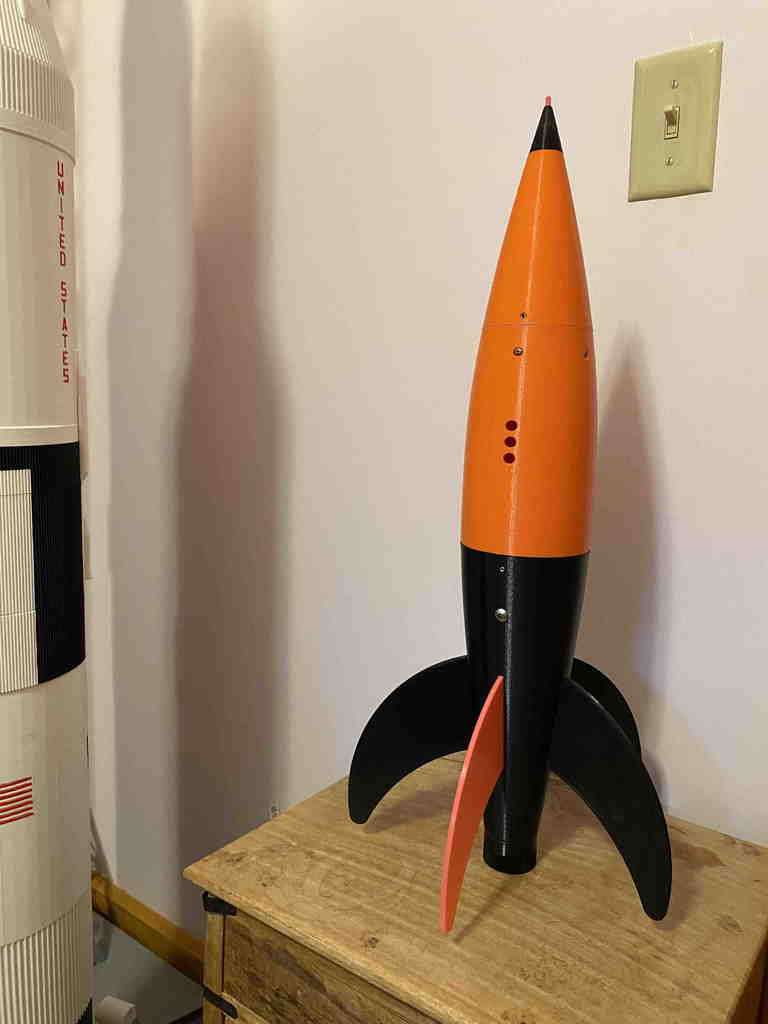
RS29
thingiverse
This is a proof of concept entirely 3D printed HPR - High Powered Rocket. This model rocket is designed to fly a 29mm case upto a 6XL CTI reload, F, G, H or I impulse motors. THIS IS NOT A TOY. While the model can be printed for display, it is meant to be flown. I designed this model for NAR or TRA Level 1 HPR certification. The advantages to the builder are several: 1) It is easy to print, modify and build to suit your tastes and requirements. 2) It is capable of an H or I impulse motor, which is necessary for Level 1 certification. 3) It can be flown with or without electronics 4) It can be flown is single deploy or dual deploy mode 5) It has easily replaceable fins in the event of a less than gentle landing for the first time certifier. (This is one of the most common reasons for a fail on an attempt, is fin damage that cannot be easily repaired, such that the rocket can be flown again) 6) It has positive motor retention utilizing an Aeropack RA29P retainer. 7) It has ample payload volume for harnesses and parachutes. 8) the nose cone can be weight adjusted to alter the CG of the rocket 9) the fins can be custom designed by the flier (a fin tab template is provided) 10) Lastly, it is very inexpensive to build. ~$20 for less than 1kg of filament. Details: 1) 29mm motor mount 2) 5 fin through the body, fully and easily replaceable by the flyer in the field. (One of the most common reasons for a Level 1 attempt fail, is a broken fin. While this can happen in this rocket, BECAUSE, this is an easy fix that can be demonstrated to the RSO and your certification witness, this will not be a reason for a fail.) 3) Less than 900 grams dry weight (eg, rocket can be completely built on a single roll of plastic) 4) Dual Deploy, Single Deploy, motor eject, motor backup, electronics backup, chute tender, and/or motor eject capable in either payload section (fore or aft). This rocket is easily configurable to the flier's needs, abilities and equipment, and not the other way around. As configured, the Avionics bay is designed to hold a Missileworks RRC3 flight computer tethered to an RTx live telemetry radio for real time flight information and downlinked GPS data, AND an RRC2+/RRC2L backup, all with isolated switching, and separate batteries. More simply it can also fly a single altimeter, or any altimeter of your choice (you, the builder, will have to print standoffs to support your electronics. These can easily be added to the existing avionics standoffs) The rocket can also be flown without electronics and rely simply on motor ejection. That is the flier's choice. This rocket is extremely versatile, in this regard. 5) NoseCone tip is removable and extra nose weight can easily be added/adjusted by the flier in the field. 6) Stability: CG was hand calculated, confirmed with commercial software (OpenRocket and RASAero) and verified by balance. CP was hand calculated with Barrowman methods, confirmed with commercial software, and verified with flight tests. The dry rocket is 0.9 cal stable, and increases to 1 cal stable with a 6-XL motor. The CP with current fin configuration is at the fore-edge of the root chord of the fins. This was a design parameter, and will not change unless you change your fin shapes. The CG will move forward, depending on your configuration. Note though, that the dry/empty CG is at the aft-coupler shear pin location. Again, this was by design. THIS SHOULD BE THE FURTHEST REAR the CG will get on this rocket, no matter your configuration. This means the MINIMUM stability is 0.9 cal, which for a short stout rocket is considered STABLE. If you build it and fly it, please let me know how it goes! Exploded views are included in the zip file as well as a build sheet. This project assumes a entry level knowledge of model rocketry and safe rocket building techniques. If this is your level 1 project, feel free to ask questions, if you are unsure. Lastly, I recommend a methylene chloride (professional plastic weld) based glue for most of the assembly (if using PET. For ABS use a bonding glue suitable for ABS*). Methylene based glues are used by professional modelers for permanent projects. The "business end" of the rocket should use a combination of this AND a high quality 2 part structural epoxy (Oddly the epoxy won't, bond the plastic, but it will add structural support). I cannot and do not recommend CA's (cyanoacrylates) it is not structural and will fail in this use. *since I personally do not print in ABS due to its inherent poor dimensional qualities, I am not able to recommend using it, or glueing with it.
With this file you will be able to print RS29 with your 3D printer. Click on the button and save the file on your computer to work, edit or customize your design. You can also find more 3D designs for printers on RS29.
